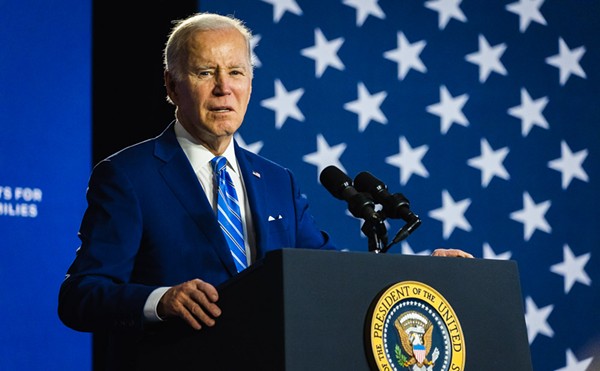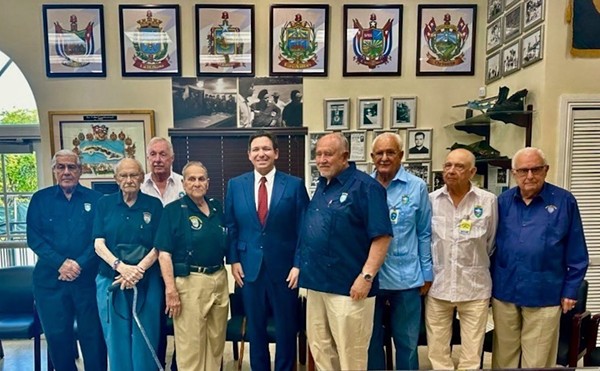One of the most jarring facts to come out of the events of Ferguson, Missouri last month — where protests took place for weeks after an unarmed black teenager was killed by a white police officer — was the paucity of minority police officers in a minority-majority town. In a city that is 67 percent African-American, only four of Ferguson's 53 police officers are black.
That recently prompted Tampa City Councilman Frank Reddick to inquire about the ratio of black and Latino officers in the Tampa Police Department.
Today Police Chief Jane Castor provided those raw numbers at the Council's weekly meeting. She said of the 954 officers in the department, a total of 31 percent are minority — 14 percent are black and 15 percent Hispanic. The city of Tampa's black population, however, is 26 percent black, and 23 percent Hispanic (The New York Times reports today that according to an analysis of a government survey of police departments, the percentage of whites on police forces is more than 30 percentage points higher than in the communities they serve).
"Those black and Hispanic numbers are not good," Reddick replied. He said he hoped that, with the city needing to add 25 new officers to the department, there could be an emphasis on hiring more minority officers. Chief Castor said that the TPD does "everything we can to recruit more minorities," but that "it's very difficult to become a police officer." Castor later told Councilman Harry Cohen that many officers the department recruits come from other police departments.
Members of the Council had a number of issues to discuss with Castor, post-Ferguson.
The Tampa Police department was hailed for the ways its members handled the protesters who flocked to Tampa during the Republican National Convention two years ago. Only two people were arrested, a statistic that Chief Castor and Mayor Bob Buckhorn have proudly trumpeted in the wake of fears that it could have been a much more explosive situation (the fact was that there were far fewer protesters who descended on Tampa and Charlotte, the host of the DNC in 2012, than during previous conventions).
But the images of a fortified police department seemingly prepared to go to war is something that Councilwoman Mary Mulhern still remembers. "It worries me that we could have that same response [as Ferguson] because we have all that gear," she pondered, prompting a cold reaction from the chief.
"I beg to differ with you on that," Castor replied. "I would like to know when you saw anybody out on civil unrest gear when there was no one out on the street."
But Mulhern said that in fact the whole country saw photos of the TPD and other local law enforcement agencies working the convention with intimidating body armor. "That happened—" she said before the chief interjected.
"That's the media's job," Castor countered. "They came from around the nation, and in several instances the media outnumbered the protesters, and frankly we all know what they were here for was to catch some type of a clash, and that didn't happen."
The chief said that she believes that the TPD has shown the ability to provide a safe environment for such protests. She boasted about many officers being on a first-name basis with protestors. "I think you'd be very hard pressed to find any other municipality around the country that had the positive relationship with the protesters in that environment than the TPD had during the RNC."
The use of military equipment supplied to local police departments has become a huge issue post-Ferguson, described by Rand Paul and others as the "over-militarization" of local law enforcement agencies. That government policy, known as the 1033 Program, has transferred $5.1 billion in military hardware from the United States Army to local American law enforcement agencies since 1997.
Castor said it's actually a good use of taxpayers' funds, since instead of the equipment being discarded by the Dept. of Defense it is recycled down to local law enforcement. "It's not that equipment itself, it's how it's utilized," she insisted.
CL reported exclusively last month that Pinellas County-based Congressman David Jolly intends to co-sponsor legislation that would require local law enforcement to be certified to be trained to use such equipment.
Another policing issue that has come out of Ferguson is the desire to have police officers wear body cameras to record their interactions with the public. The Washington D.C. Metropolitan Police Department plans to issue body-mounted cameras to a test group of officers beginning Oct. 1 as part of a six-month citywide pilot program to explore the technology. And in New York City, Police Commissioner William Bratton was scheduled to announce today that cops in five different precincts will soon be wearing the recording devices.
"My prediction is that within five years, every officer in America will be wearing a body camera." Castor said, adding that the department by the end of the year will have 60 such cameras to test in all three police stations.
















